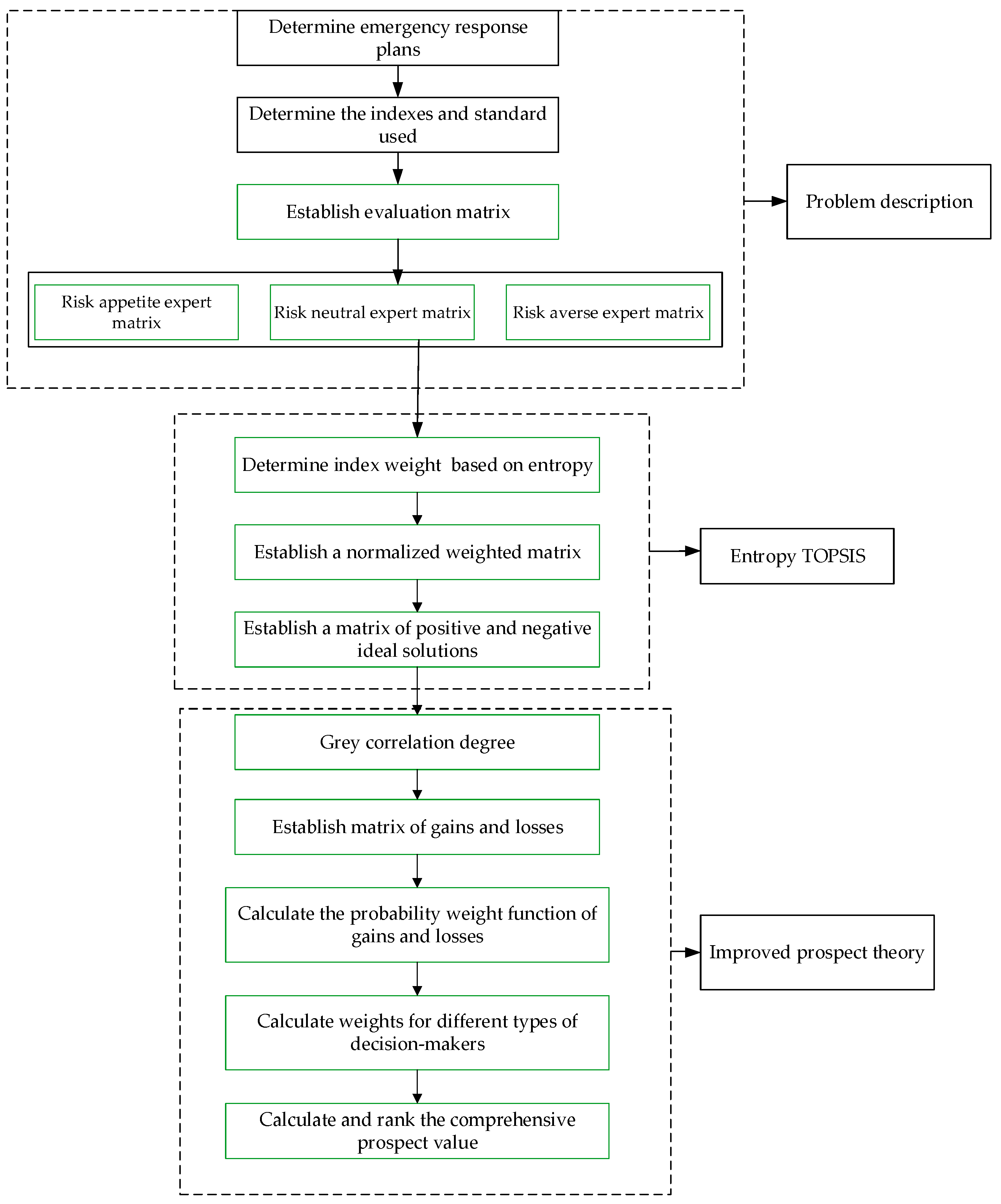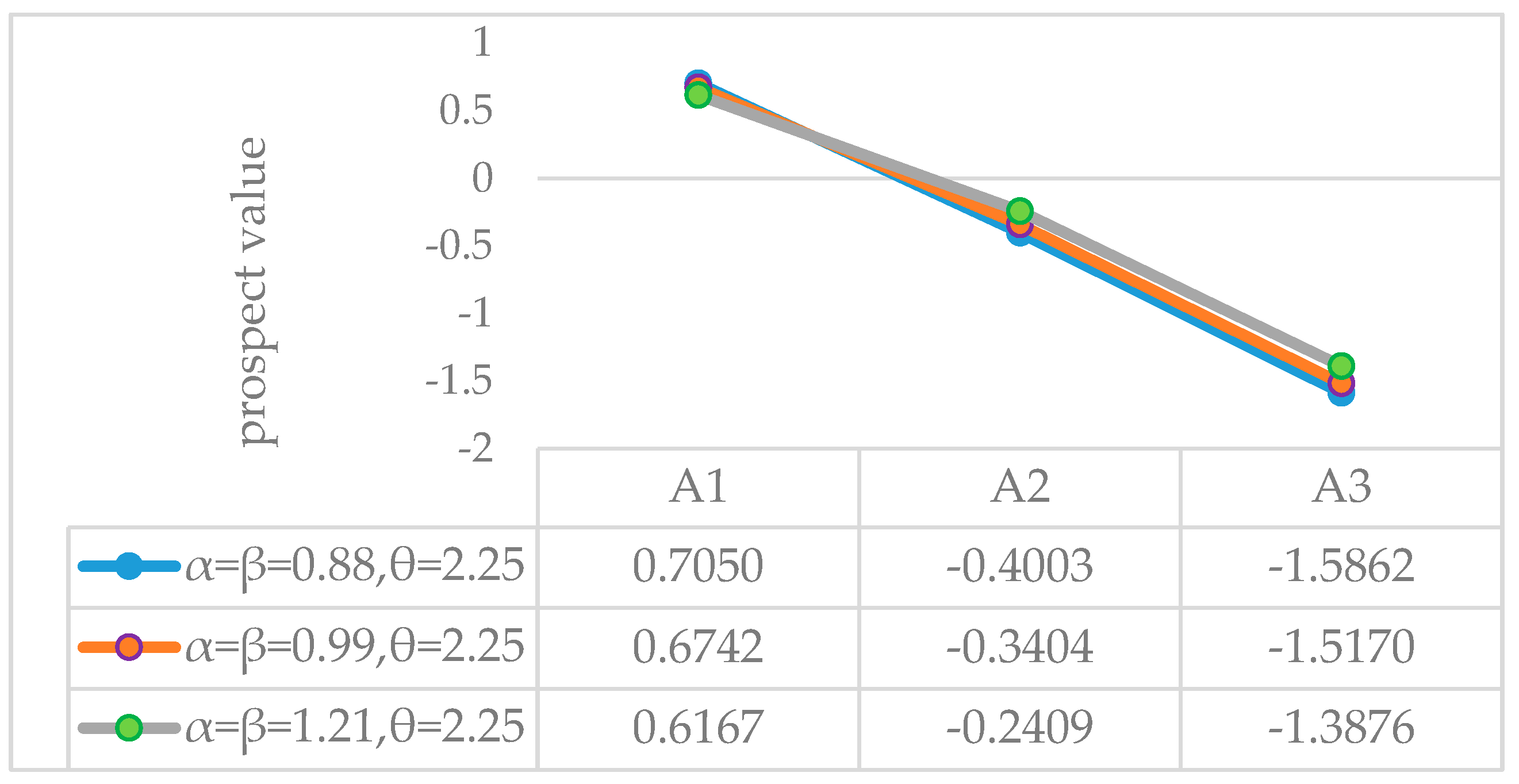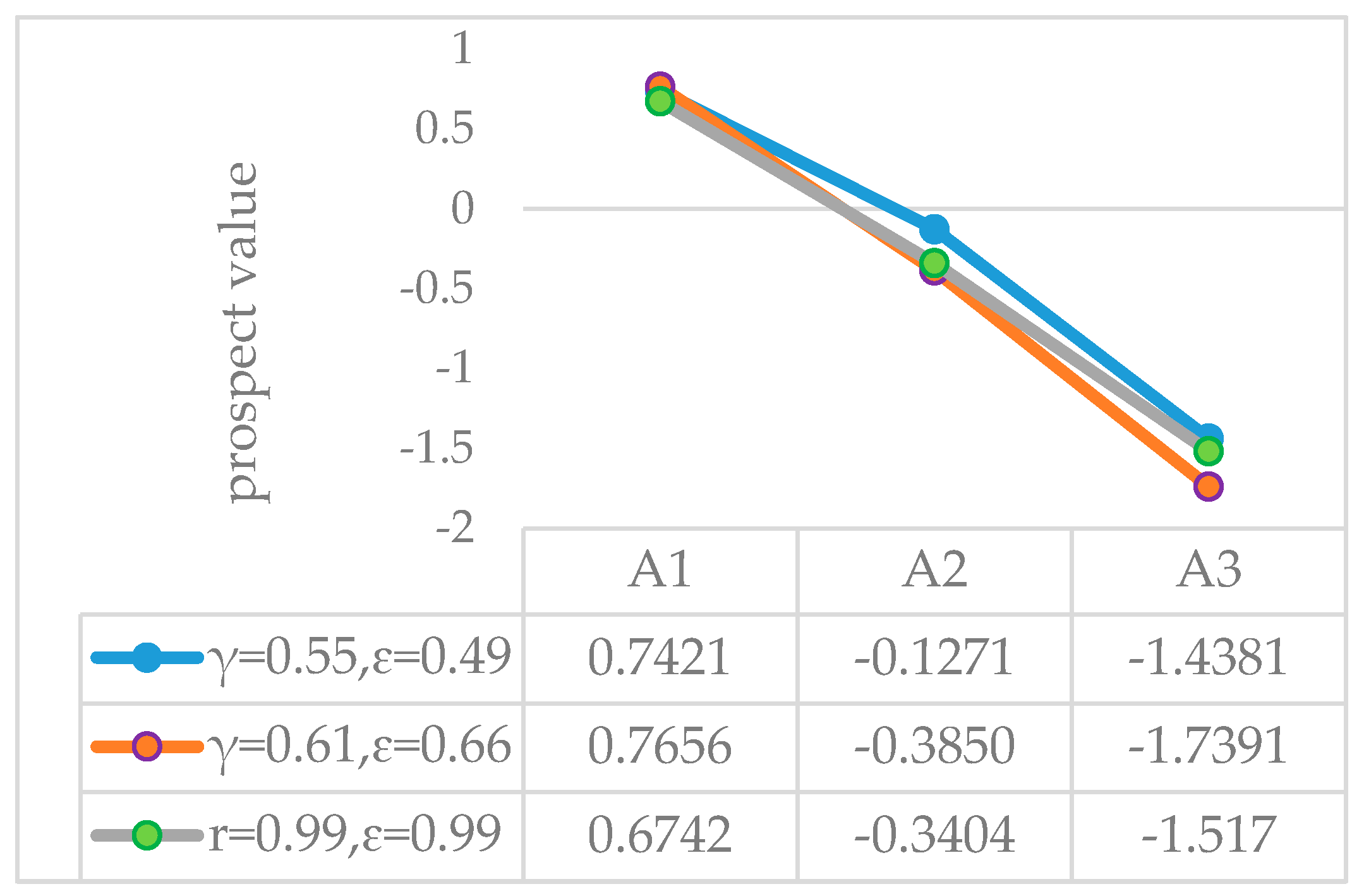An Emergency Decision-Making Method for Coal Spontaneous Combustion Based on Improved Prospect Theory
Abstract
1. Introduction
2. Index System of Emergency Response Plan for Spontaneous Combustion
- (1)
- Safety: This primarily considers the ability to address current accidents and prevent potential risks, including the possibility of triggering new secondary disasters or causing harm to trapped individuals and rescuers. It encompasses organizational and personal factors, rational decision-making, adherence to emergency procedures, and the prediction of potential hazardous areas.
- (2)
- Feasibility: Feasibility assesses the practicality of implementing the emergency response plan, considering challenges in dangerous areas, physical exertion required by rescuers, the appropriateness of escape routes and shelter arrangements, as well as the effective protection of rescue equipment.
- (3)
- Timeliness: This refers to the promptness with which the emergency response plan can control and mitigate accidents, evaluating its efficiency in handling emergencies. It includes the swift generation/activation of an emergency response plan, quick and robust emergency support, and high-efficiency information reporting and approval processes.
- (4)
- Effectiveness: This primarily pertains to whether implementation will enhance disaster management, control development trends, and prevent secondary disaster incidents from occurring.
3. Related Theories and Emergency Decision-Making Method
3.1. Improved Prospect Theory
3.1.1. The Improved Prospect Value
3.1.2. The Improved Prospect Value Function
3.1.3. The Probability Weight Function of Gains and Losses
3.2. Entropy TOPSIS Method
3.3. Grey Correlation Degree
3.4. Emergency Decision-Making Method for Coal Spontaneous Combustion
3.4.1. Emergency Decision-Making Procedure for Coal Spontaneous Combustion
3.4.2. Specific Steps
4. Case Study
4.1. Accident Overview
4.2. Coal Mine Overview
4.3. Emergency Response Plan
- (1)
- Emergency response plan :
- (2)
- Emergency response plan :
- (3)
- Emergency response plan :
4.4. Emergency Decision-Making
4.4.1. Establish the Fuzzy Evaluation Matrix
4.4.2. Establish the Weighted Normalized Matrix
4.4.3. Calculate the Positive and Negative Ideal Solutions
4.4.4. Calculate the Grey Correlation Degree
4.4.5. Establish Gain Matrix and Loss Matrix
4.4.6. Calculate the Probability Weight
4.4.7. Calculate the Prospect Values
4.4.8. The Decision-Making Results
5. Discussion
5.1. Comparative Analysis of Decision Makers with Different Risk Types
5.2. Comparative Analysis of Risk Coefficients
5.3. Comparative Analysis Using Different Calculation Methods for Index Weights
5.4. Comparative Analysis Using Different Methods for Decision-Making
6. Conclusions
Author Contributions
Funding
Data Availability Statement
Acknowledgments
Conflicts of Interest
References
- Zhao, X.G.; Dai, G.L. Experimental study on spontaneous combustion characteristics of oxidized coal. J. Saf. Sci. Technol. 2020, 16, 55–60. [Google Scholar]
- Xia, T.; Zhou, F.; Wang, X.; Zhang, Y.; Li, Y.; Kang, J.; Liu, J. Controlling factors of symbiotic disaster between coal gas and spontaneous combustion in longwall mining gobs. Fuel 2016, 182, 886–896. [Google Scholar] [CrossRef]
- Wen, H.; Wang, H.; Liu, W.; Cheng, X. Comparative study of experimental testing methods for characterization parameters of coal spontaneous combustion. Fuel 2020, 275, 117880. [Google Scholar] [CrossRef]
- Shi, Q.L. Study on the Theory and Properties of Colloidal Foam for Controlling and Preventing Coal Spontaneous Combustion. Ph.D. Thesis, China University of Mining and Technology, Xuzhou, China, 2019. [Google Scholar]
- Wen, H.; Wu, K.; Cao, X.G. Fire prevention and control technology with inhibition inertia foam to prevent coal spontaneous combustion in high ground temperature deep mine. Coal Sci. Technol. 2014, 42, 108–111. [Google Scholar] [CrossRef]
- Xu, Z.; Zhang, X. Hesitant fuzzy multi-attribute decision making based on TOPSIS with incomplete weight information. Knowl. Based Syst. 2013, 52, 53–64. [Google Scholar] [CrossRef]
- Qiu, M.; Huang, F.; Wang, Y.; Guan, T.; Shi, L.; Han, J. Prediction model of water yield property based on GRA, FAHP and TOPSIS methods for Ordovician top aquifer in the Xinwen coalfield of China. Environ. Earth Sci. 2020, 79, 214. [Google Scholar] [CrossRef]
- Guo, Y.; Shi, Q.; Guo, C. A Performance-Oriented Optimization Framework Combining Meta-Heuristics and Entropy-Weighted TOPSIS for Multi-Objective Sustainable Supply Chain Network Design. Electronics 2022, 11, 3134. [Google Scholar] [CrossRef]
- Chen, P. Effects of the entropy weight on TOPSIS. Expert Syst. Appl. 2021, 168, 114186. [Google Scholar] [CrossRef]
- Liu, Y.; Li, L.; Tu, Y.; Mei, Y. Fuzzy TOPSIS-EW Method with Multi-Granularity Linguistic Assessment Information for Emergency Logistics Performance Evaluation. Symmetry 2020, 12, 1331. [Google Scholar] [CrossRef]
- Cengiz, L.D.; Ercanoglu, M. A novel data-driven approach to pairwise comparisons in AHP using fuzzy relations and matrices for landslide susceptibility assessments. Environ. Earth Sci. 2022, 81, 222. [Google Scholar] [CrossRef]
- Zhou, X.; Ren, S.; Zhang, S.; Zhang, J.; Wang, Y. Risk Evaluation Model of Coal Spontaneous Combustion Based on AEM-AHP-LSTM. Mathematics 2022, 10, 3796. [Google Scholar] [CrossRef]
- Hu, J.; Xu, B.; Chen, Z.; Zhang, H.; Cao, J.; Wang, Q. Hazard and risk assessment for hydraulic fracturing induced seismicity based on the Entropy-Fuzzy-AHP method in Southern Sichuan Basin, China. J. Nat. Gas Sci. Eng. 2021, 90, 103908. [Google Scholar] [CrossRef]
- Liu, Y.; Eckert, C.M.; Earl, C. A review of fuzzy AHP methods for decision-making with subjective judgements. Expert Syst. Appl. 2020, 161, 113738. [Google Scholar] [CrossRef]
- Yao, X.; Guo, H.; Zhu, J.; Shi, Y. Dynamic selection of emergency plans of geological disaster based on case-based reasoning and prospect theory. Nat. Hazards 2022, 110, 2249–2275. [Google Scholar] [CrossRef]
- Li, H.M.; Li, F.; Zuo, J.; Sun, J.B.; Yuan, C.H.; Ji, L.; Ma, Y.; Yao, D.S. Emergency Decision-Making System for the Large-Scale Infrastructure: A Case Study of the South-to-North Water Diversion Project. J. Infrastruct. Syst. 2022, 28, 04021051. [Google Scholar] [CrossRef]
- Chen, W.; Wang, X.; Wang, W.; Zhu, Y.; Cai, Z.; Yang, S. A heterogeneous GRA-CBR-based multi-attribute emergency decision-making model considering weight optimization with dual information correlation. Expert Syst. Appl. 2021, 182, 115208. [Google Scholar] [CrossRef]
- Wang, C.-N.; Yang, F.-C.; Vo, T.M.N.; Nguyen, V.T.T.; Singh, M. Enhancing Efficiency and Cost Effectiveness: A Ground-breaking Bi-Algorithm MCDM Approach. Appl. Sci. 2023, 13, 9105. [Google Scholar] [CrossRef]
- Nguyen, V.T.T.; Wang, C.; Yang, F.; Vo, T.M.N. Efficiency Evaluation of Cyber Security Based on EBM-DEA Model. Eurasia Proc. Sci. Technol. Eng. Math. 2022, 17, 38–44. [Google Scholar] [CrossRef]
- Cimellaro, G.P.; Reinhorn, A.M.; Bruneau, M. Framework for Analytical Quantification of Disaster Resilience. Eng. Struct. 2010, 32, 3639–3649. [Google Scholar] [CrossRef]
- Forcellini, D. An Expeditious Framework for Assessing the Seismic Resilience (SR) of Structural Configurations. Structures 2023, 56, 105015. [Google Scholar] [CrossRef]
- Du, Y.W.; Wang, S.S.; Yang, N.; Zhou, W. Multiple attribute large-group decision-making method with incomplete information by considering expert’s knowledge structure. Chin. J. Manag. Sci. 2017, 25, 167–178. [Google Scholar] [CrossRef]
- Kahneman, D.; Tversky, A. Prospect Theory: An Analysis of Decision under Risk. Econometrica 1979, 47, 263–291. [Google Scholar] [CrossRef]
- Kahneman, A.T.D. Advances in Prospect Theory: Cumulative Representation of Uncertainty. J. Risk Uncertain. 1992, 5, 297–323. [Google Scholar]
- Song, Z.J.; Wang, H.; Zhao, H.M.; Chen, Y.H. Method and application for multi-scenario hybrid risk decision making based on utility-risk entropy. Syst. Eng. Electron. 2018, 40, 2751–2757. [Google Scholar] [CrossRef]
- Jia, F.; Wang, X. Rough-Number-Based Multiple-Criteria Group Decision-Making Method by Combining the BWM and Prospect Theory. Math. Probl. Eng. 2020, 2020, 1–16. [Google Scholar] [CrossRef]
- Zhao, H.; Guo, S.; Zhao, H. Comprehensive assessment for battery energy storage systems based on fuzzy-MCDM considering risk preferences. Energy 2019, 168, 450–461. [Google Scholar] [CrossRef]
- Ge, B.; Zhang, X.; Zhou, X.; Tan, Y. A Cumulative Prospect Theory Based Counterterrorism Resource Allocation Method under Interval Values. J. Syst. Sci. Syst. Eng. 2019, 28, 478–493. [Google Scholar] [CrossRef]
- Lee, M.C.; Park, J. Compensating Qualitative Rating Distortion of User Experience Evaluation Based on Prospect Theory. Sustainability 2019, 11, 6815. [Google Scholar] [CrossRef]
- Xing, H.; Song, L.; Yang, Z. An Evidential Prospect Theory Framework in Hesitant Fuzzy Multiple-Criteria Decision-Making. Symmetry 2019, 11, 1467. [Google Scholar] [CrossRef]
- Li, L.L. Study on the Secondary Explosion Rule in Disaster Area and Emergency Decision-Making Model of Coal Mine Gas Explosion. Ph.D. Thesis, China University of Mining and Technology (Beijing), Beijing, China, 2019. [Google Scholar]
- Liu, W.J. Research on Emergency Response Group Decision-Making Based on Prospect Theory. Master’s Thesis, Jiangnan University, Wuxi, China, 2018. [Google Scholar]
- Liu, P.; Jin, F.; Zhang, X.; Su, Y.; Wang, M. Research on the multi-attribute decision-making under risk with interval probability based on prospect theory and the uncertain linguistic variables. Knowl. Based Syst. 2011, 24, 554–561. [Google Scholar] [CrossRef]
- Omrani, H.; Alizadeh, A.; Naghizadeh, F. Incorporating decision makers’ preferences into DEA and common weight DEA models based on the best–worst method (BWM). Soft. Comput. 2020, 24, 3989–4002. [Google Scholar] [CrossRef]
- Liu, Q.; Jin, S.; Yao, L.; Shen, D. The revisited total least squares problems with linear equality constraint. Appl. Numer. Math. 2020, 152, 275–284. [Google Scholar] [CrossRef]
- Chaji, A. Analytic approach on maximum Bayesian entropy ordered weighted averaging operators. Comput. Ind. Eng. 2017, 105, 260–264. [Google Scholar] [CrossRef]
- Pamučar, D.; Ecer, F.; Cirovic, G.; Arlasheedi, M.A. Application of Improved Best Worst Method (BWM) in Real-World Problems. Mathematics 2020, 8, 1342. [Google Scholar] [CrossRef]
- Vafadarnikjoo, A.; Tavana, M.; Botelho, T.; Chalvatzis, K. A neutrosophic enhanced best–worst method for considering decision-makers’ confidence in the best and worst criteria. Ann. Oper. Res. 2020, 289, 391–418. [Google Scholar] [CrossRef]
- Wang, J. Research on Coal Mine Emergency Response Decision-Making under Uncertain Environment. Ph.D. Thesis, Liaoning Technical University, Fuxin, China, 2019. [Google Scholar]
- Lu, C.; Zhao, M.; Khan, I.; Uthansakul, P. Prospect Theory based Hesitant Fuzzy Multi-Criteria Decision Making for Low Sulphur Fuel of Maritime Transportation. Comput. Mater. Contin. 2021, 66, 1511–1528. [Google Scholar] [CrossRef]
- Li, A.; Zhao, Z. Crane Safety Assessment Method Based on Entropy and Cumulative Prospect Theory. Entropy 2017, 19, 44. [Google Scholar] [CrossRef]
- Zhang, N.; Fang, Z.; Liu, X. Grey Situation Group Decision-Making Method Based on Prospect Theory. Sci. World J. 2014, 2014, 703597. [Google Scholar] [CrossRef][Green Version]
- Zeng, J.M. An experimental test on cumulative prospect theory. J. Jinan Univ. Nat. Sci. Med. Ed. 2007, 28, 44–47. [Google Scholar]
- Ma, J.; Sun, X.X. Modified value function in prospect theory based on utility curve. Inf. Control 2011, 40, 501–506. [Google Scholar]
- Gao, J.W.; Guo, F.J. Intuitionistic fuzzy stochastic multi-criteria decision-making method based on modified prospect theory. Control Decis. 2019, 34, 317–324. [Google Scholar] [CrossRef]
- Xu, H.; Zhou, J.; Xu, W. A decision-making rule for modeling travelers’ route choice behavior based on cumulative prospect theory. Transp. Res. Part C Emerg. Technol. 2011, 19, 218–228. [Google Scholar] [CrossRef]
- Zeng, J.; Jing, G.; Zhu, Q.; Sun, H. Emergency Response Plan for Spontaneous Combustion Based on Case-Based Reasoning. Processes 2023, 11, 2151. [Google Scholar] [CrossRef]
- Tan, R.; Zhang, W.; Yang, L.; Chen, S. Multi-Attribute Decision-Making Method Based on Prospect Theory in Heterogeneous Information Environment and Its Application in Typhoon Disaster Assessment. Int. J. Comput. Int. Syst. 2019, 12, 881. [Google Scholar] [CrossRef]
- Zhao, H.; Guo, S.; Zhao, H. Comprehensive Performance Assessment on Various Battery Energy Storage Systems. Energies 2018, 11, 2841. [Google Scholar] [CrossRef]





| Grade | I | II | III | IV | V |
|---|---|---|---|---|---|
| core range | [1, 2) | [2, 4) | [4, 6) | [6, 8) | [8, 10) |
Disclaimer/Publisher’s Note: The statements, opinions and data contained in all publications are solely those of the individual author(s) and contributor(s) and not of MDPI and/or the editor(s). MDPI and/or the editor(s) disclaim responsibility for any injury to people or property resulting from any ideas, methods, instructions or products referred to in the content. |
© 2024 by the authors. Licensee MDPI, Basel, Switzerland. This article is an open access article distributed under the terms and conditions of the Creative Commons Attribution (CC BY) license (https://creativecommons.org/licenses/by/4.0/).
Share and Cite
Zeng, J.; Jing, G.; Zhu, Q. An Emergency Decision-Making Method for Coal Spontaneous Combustion Based on Improved Prospect Theory. Processes 2024, 12, 151. https://doi.org/10.3390/pr12010151
Zeng J, Jing G, Zhu Q. An Emergency Decision-Making Method for Coal Spontaneous Combustion Based on Improved Prospect Theory. Processes. 2024; 12(1):151. https://doi.org/10.3390/pr12010151
Chicago/Turabian StyleZeng, Jingwei, Guoxun Jing, and Qifeng Zhu. 2024. "An Emergency Decision-Making Method for Coal Spontaneous Combustion Based on Improved Prospect Theory" Processes 12, no. 1: 151. https://doi.org/10.3390/pr12010151
APA StyleZeng, J., Jing, G., & Zhu, Q. (2024). An Emergency Decision-Making Method for Coal Spontaneous Combustion Based on Improved Prospect Theory. Processes, 12(1), 151. https://doi.org/10.3390/pr12010151





